- NEW DVD Series – Stone Setting with Bezels
- Tube Set Charm by Kim St. Jean
- Prong Basket Pendant by Kim St. Jean
- NEW DVD Series – Stone Setting with Cold Connections
- New DVD Series – Stone Setting with Wire
- NEW DVD Series: Introduction to Stone Setting by Kim St. Jean
- Featured Tool: Bracelet Bending Plier
- NEW Dvd by Eva Sherman
- Fun, Fast Fold Forming DVD Series
- Double Band Ear Cuff from Alex Simkin
Daily Wire Tip: Copper Wire Temper
Daily Wire Jewelry Making Tip
Question:
Dale, I have to come clean. I am not a wire artist, always been afraid to try it, because precious metal is so high these days. I’ve been doing intricate bead work for several years, and it sells.
But I just got brave and bought 15 yards of 20-gauge round copper wire, cause it was really cheap, and some bags of pretty colored garden stones to practice with as pendants. My problem is, I don’t know what hardness this copper wire is, it doesn’t say. Is there a way to tell?
-Lorraine in Granite City, Illinois
Answer:
First Lorraine, you are not alone! Many folks purchase wire because of the price and have no idea what the temper is. So let’s talk a bit about copper wire tempers.
Although copper wire can be purchased in a full hard temper, it is unusual to find among jewelry wire suppliers; most of what is available is either half hard or dead soft (same as soft).
The copper wire found in hardware stores is most often soft. Depending on the gauge a wire artist wishes to work with, soft is the most popular, because it is fun and easy to forge or texture, and will not work harden quickly.
The easiest way to determine the temper of your 20-gauge copper wire: in one hand, hold it about 3″ down from one end and use your finger to push the end. If it bends quite easily, it is soft; if it has some resistance, it is half hard. If you can hardly get it to bend, it is full hard.
Remember the most foolish question is the one you don’t ask!
Answer contributed by Dale “Cougar” Armstrong
Have a Question? Click Here to Submit Your Question
Click to Receive Daily Tips by Email






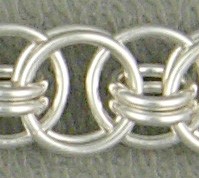
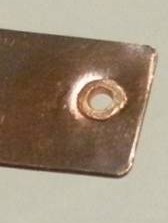


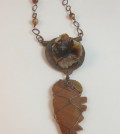




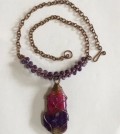


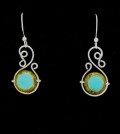




Nancy Keane
December 21, 2010 at 8:50 am
I don’t know whether to say WOW! or DUH. What a great way to discover the temper of wire. Seems obvious now that you have described it, but I would never have thought of it myself. It’s a great way to figure out what temper that wire is that you bought and forgot to label. Not that I would ever do that, of course. LOL. I buy a lot of silver and copper wire, and just saying ….
Ginni Tutterow
December 21, 2010 at 9:02 am
Also note the degree of “spring back”. If the wire stays where you put it, it is soft. If it partially returns to the original position it is half hard.
Diane
December 21, 2010 at 12:46 pm
If the copper wire is too soft for your project, you can harden it a bit by pounding it before you work with it. Use a piece of thin leather to protect the wire from being marred. Fold the leather over so your wire goes through it and pound it gently using a hammer and your bench block or anvil. It does not take much pounding to harden it too much; if it gets too hard it becomes brittle. Just hit it once or twice for each hammer-length of wire. You’ll get the hang of it with a lttle practice.
Lorraine Brooks
December 22, 2010 at 5:50 am
Gee, Thanks Dale. I feel like Nancy, Wow or Duh, it makes so much sense the way you describe it. I too would have never thought of that. Two or more heads are always better than one.
You say it Dale and it’s like a light comes on. My hubby has arthritis, so my intent is to fashion him a bracelet, plain & simple. I have the look I want in my head, so if I can figure out how, I’ll send you an image of it so you can have a good laugh with me at my first attempt. Thanks so much!
dalecgr
December 22, 2010 at 9:54 am
Lorraine, my husband sometimes tells me that simple things elude me, so you are not alone : ) I would love to see your first bracelet!
Judy Hansen
December 24, 2010 at 2:44 pm
I just made my first wire wrap with copper. I was surprised I scratched it when I made my pulls. But…I am really hooked on this field of art. It is so worth jumping in and giving it a try.
Jan Garbacz
December 25, 2010 at 1:49 pm
I love to buy craft wire and never knew how to tell the hardness either. Copper is one of my favorites. Does this hardness test apply to all wires or just copper?
Thanks so much.
dalecgr
December 26, 2010 at 1:31 am
Hi Jan – it will apply to all wire except stainless steel due to the fact that steel is really hard!
Joni Stinson
December 29, 2010 at 11:58 am
What a great question and I learned from the answer! My wrapping skills are limited at this time and these little “nuggets” of knowledge sure help. Plan to work more in wire in 2011! Thanks.
Sandy
August 7, 2012 at 6:20 am
I have been using hardware store copper for a long time. I have to go to 2 different stores because not all stores carry the same gauges. They also have copper and aluminum sheets in small sizes. I actually go to the hardware store to shop first for a number of supplies. If they have it, it’s cheaper than at the craft store next store. I found a wonderful tool caddy, and the butane torches are also better priced.
Alan Taylor
August 7, 2012 at 6:42 am
I love working with copper because of its’ warmth and the way it ages. I tell people that silver tarnishes, copper matures. I only use silver when the color of the stone would be lost in copper. A red tiger eye for example.
On the rare occasions that I need a really large gauge for a project, I’ll get it at a hardware store. They routinely stock 10, 12 and larger gauges and it being dead soft is an important plus. When you try to work with something that big, temper is the difference between a beautiful piece and a separated shoulder.
kitty spanos
August 7, 2012 at 10:33 am
I’m with you Alan, I love working with copper for its own sake. Looks great with blues and greens like turquoise, amazonite and lapis for example.
Robin Burns
August 7, 2012 at 8:16 am
Garden stones are a great idea for practice cabs, too – I’ve been using the little glass drops in the decor section at the Dollar Store or Walmart as practice cabochons. Sometimes they come in perfect circles about 30mm, great for pendants, and the smaller drops make good earrings. They are pretty enough to use with copper wire for inexpensive sale items as well. Some of them are iridescent and I’ve seen them sold for pretty high prices as “stones” for jewelry even on Ebay!
Barbara Dowd
August 7, 2012 at 8:19 am
I have a question that has me plaqued…how do you use craft wire to wrap cabs? I have been taught to use sq. half-hard and half round for wrapping the wires together. I love the colors of craft wire and the price…but am afraid to do it…is there a technique? Or, just what does one use craft wire for? You have said that there is no dumb question and I hope to see an answer.
I have learned all sorts of good things from these tips and the videos I have purchased. Love the look of wire wrapped items. I look forward to an answer.I thank you for your help.
Sandy
August 11, 2012 at 7:16 pm
Barbara, You can use round wire, rather than square, to wrap cabs. It’s a little tricky because of the round edges, but doable. I use 22g for the bundle and 24 or 26 for the wraps. I also use a lot of blue painter’s tape to keep the bundle manageable. And be careful with the wire so you don’t nick it with your tools. It’s also rather soft so I keep the fillagree work on the top rather simple.
Grace
February 27, 2013 at 12:44 am
Temper is one of the trickiest things to understand for new wire workers, and it’s one of the first things I cover in my beginning wire wrapping classes. I’m a huge fan of half-hard for most of my “structural” elements, but I love soft wire for all of my bezel work and any wires that will be ornamental. Copper is a great wire to work with, and with the cost of most metals going up, up and away, copper is becoming my very best friend! Your trick is a great one, Dale!
Dawn
May 24, 2013 at 4:40 pm
Help please! I’m working with women in Lusaka, Zambia making copper jewelry. We managed to find some old wire that was hard enough for ear wires but our supply has run out and everything we find is so soft. It doesn’t work harden by all the techniques named above. No matter how much I strike it with a leather mallet it stays soft – not a good option for ear wires. Does anyone have a suggestion or know what I can do?
Dane Lavery
July 26, 2013 at 7:44 pm
Dawn…I do not know if this will work for you. You might try cold drawing through a die which in your case will be a steel plate held in a vice with holes drilled in it which are slightly smaller than the gauge of wire you have to get you down to a desired gauge.
Here in Japan I can buy a ready made plate from the Home Center which is actually meant for sizing strips of bamboo but works OK with copper wire.It’s about $10….however I am guessing you may have to make your own if you cannot find something like this locally.
For the die plate you need a plate ~ 6mm or thicker will be OK.
To minimize friction you need reduce the thickness of the plate where the die hole will be drilled. Wear gloves and eye protection. Place the plate in a vice. First drill using a larger drill to carefully drill away material on one side.Use slow speed and apply cutting oil. DO NOT DRILL RIGHT THROUGH THE PLATE. Leave yourself about 1 mm of plate thickness and then drill through with a drill which is the size of die hole that you want. This will also give you a slight taper to help guide the wire into the die hole.Pack that taper with grease to help lubricate the wire as you cold draw the wire.
You will need to reduce the end of the wire by tapping it with a hammer and rotating the wire on a hard surface.You need to reduce enough to poke through the die hole and get a grip on it with a pair of mole grips.
Wipe grease down the whole length of the wire. Then pull the wire through the die. Use a series of increasingly smaller holes which will give you small reductions in diameter for each pull. This will get you down to your desired gauge easily. Each pull will harden and straighten the wire. As you reduce the diameter of the wire it will get longer.
Obviously you will lose any varnish on the wire and you will need to degrease the wire after you have pulled it to gauge.
This is messy, hard and will require your perseverance and determination but it will work for you.
One other thing you need…A gentleman friend with large biceps or failing that and be really careful if you go this way, a clamp connected to a manual or motorized winch.
Winches even small ones are dangerous. Please take all usual sensible safety precautions when doing this…If you don’t know what those are find someone locally who does and can help you at the location where you try this. Once you start using winches you can develop very large forces and you need to always be out of the firing line every time you try something like this.
In general, rig pulleys to reverse direction of pull so you can stand behind the die during pulling, rig some sort shield, eye protection (preferably a face guard), hand protection, a leather apron would be a starting point. Avoid pulling wire with kinks in it.
I cannot be of further use without getting into a lot more detail about starting gauge and finish gauge and so on.
Good luck and stay safe.
candy
June 4, 2014 at 7:53 pm
A few years ago I had to re-wire a mobile home from the electrical pole [20 feet from the home + 60 feet underground to the box] 3 strands of
3awg copper wire approx. 250 feet in all. I bought a 400 foot spool. I take a 5ft section of the leftovers [use cable cutters]. I strip the black plastic cover from it and I have 5 feet of twisted wires 18ga ds round & 14ga ds round. I untwist all the wires and put each on an empty spool. then go through the cutting and spooling again. After all these years I can still get about 10 more 5 foot strands and they probably cost $.03 each 5 ft wire. 100% copper, too. There are 12- 15 wires in each strand. [more 14 ga than 18 gauge]. It’s the cheapest practice wire I’ve found, but I make some really nice pieces with it, also.
visit website
March 29, 2015 at 2:01 am
I think your information is the best I have ever seen. Thnx a lot for posting the interesting info.
Julie
April 7, 2015 at 6:09 am
I wanted to try chainmail jewelry and I love the colored wire, but can the enameled craft wire be used to make jump rings? Can you harden this wire using the methods you describe?
And also same question for the silver plated copper craft wire.
Or are these wires just too soft? Would one be better than the other?
Lillian Moore
May 17, 2016 at 3:39 pm
Thanks for the article! I thought it was interesting that copper wire found in hardware stores is usually soft metal. Making sure you know what kind of wire you are using can bring out a different type tempering. I like the suggestion to just try to bend the wire and if it doesn’t bend easily means the hardness of the metal is softer. I really enjoyed your comment I really appreciate knowing the difference between the hardnesses of metals.
sumit
May 11, 2017 at 3:01 am
Copper is more ductile with relatively high tensile strength
suman
August 16, 2017 at 12:17 am
The fact that copper wires have played a significant role in human development.
Thanks for the article!
suman
August 16, 2017 at 12:19 am
Thanks for article and sharing a valuable information about copper wire temper,
In today world copper wires have played a significant role in human development.